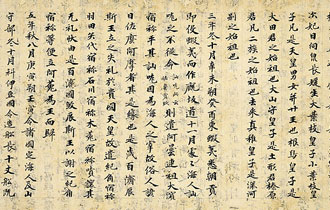Pages |
Dutch examples from this period include: arukōru 'alcohol' (Dutch alcohol 'alcohol'), kanfuru 'campher' (Dutch kamfer 'campher'), supoito 'dropper' (Dutch spuit 'dropper'), mesu 'surgical knife' (Dutch mes 'knife'), madorosu 'sailor' (Dutch matroos 'sailor'), konpasu 'compass' (Dutch kompas 'compass'), ponpu 'pump' (Dutch pomp 'pump'), buriki 'sheet metal' (Dutch blik 'sheet metal'), zukku 'canvas' (Dutch doek 'canvas') , penki 'paint' (Dutch pek 'paint'), garasu 'glass' (Dutch glas 'glass'), giyaman 'glass, glassware, cut glass' (Dutch diamant 'diamond (used to cut glass)'), kōhii 'coffee' (Dutch koffie 'coffee'), biiru 'beer' (Dutch bier 'beer').
Borrowing toward the end of the Tokugawa Era through the End of Taisho
A third and very vibrant period of vocabulary borrowing came about at the end of the Edo period and extending through the first quarter of the 20th century, roughly 1850 through 1925. The floodgate of borrowing first opened in the 1850s and 1860s when Japan began participating in international commerce with the United States, England, and other countries. Along with the foreign good and foreigners of all stripes came additional vocabulary. Also in the beginning of the Meiji period (1868-1912) the new fledgling modern nation invited a large number of foreigners to help build its infrastructure in all governmental, industrial, commercial, and academic sectors. Teaching of these foreigner (called oyatoi gaijin 'foreigners for hire') touched on virtually every aspect of modern life in the West. These foreign employees naturally brought their own specialized terminology into the Japanese language. Concurrent with this development, many Japanese citizens went to the West to study in all types of disciplines, experience a different lifestyle firsthand, absorb knowledge, and bring back newly acquired knowledge to Japan, all in a feverish effort to modernize Japan quickly.
The spectrum of new vocabulary and their origins brought in during Meiji (1868-1912) are emblematic of the countries that had strong influence on Japan in certain fields at that time. Spanish and Portuguese were no longer common sources of borrowing; instead common source languages were English (England and the United States), Italian, French, and German. A relatively small number of words came from Russian. Examples from this period are numerous. English offered a lot in the food department and in other daily vocabulary: harashiraisu 'rice and beef hash' from hashed rice, bihuteki 'beefsteak' from beef steak, karee 'curry and rice' from curry and rice, ramune 'lemony sweet soda water' from lemonade, tomato 'tomato', faazaa 'father', annachuraru 'unnatural', bukku 'book', redikyurasu 'ridiculous', to name just a few. Some of these died out quickly, such as the last four in this list. German loanwords relate to medicine, philosophy and outdoor sports and they include purusu from Puls 'pulse', karute 'medical file' from Karte 'medical file', gaaze from Gaze 'surgical gauze,' teez 'thesis' from These 'thesis', zairu 'climbing rope' from Seil 'rope', hyutte 'cabin' from Hütte 'cabin', to name a few. French contributed such words as atorie 'atelier' from atelier 'artist's studio', puretaporute 'ready to wear' from pret à porter 'ready to wear', abekku 'pair of man and woman lovers' from avec 'with', ankōru 'curtain call' from encore, konkūru 'competition' from concours. Many Italian loans relate to music, as in tenpo 'tempo' from tempo, areguro 'allegro' from allegro, just to name two. Russian contributed pechika 'fireplace' (from Russian pechka), interi 'intelligentsia' (from Russian intelligentsiya).
Pages |











